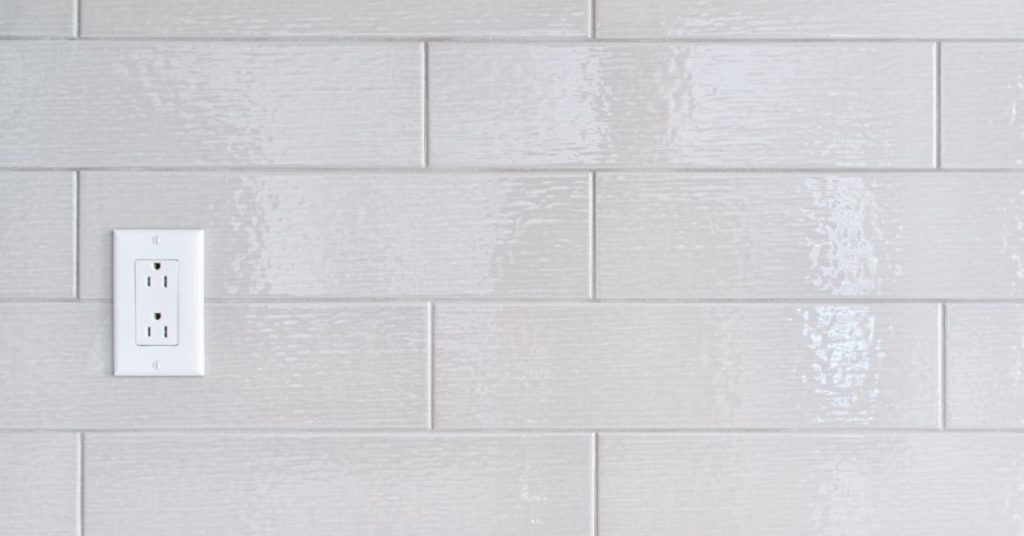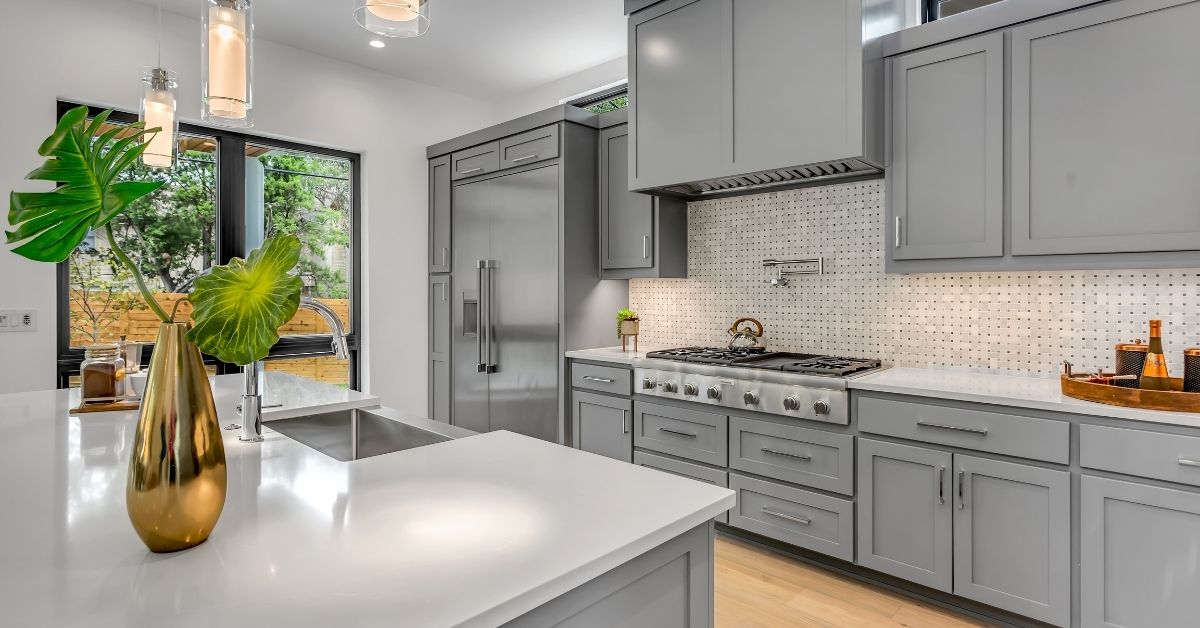GFCIs have been around for decades. Back then, you had to install them on exterior outlets. But today, the NEC has expanded the technology’s use considerably. You have to install them in bathrooms, unfinished basements, crawl spaces, and, most importantly, kitchens. But do you have to add GFCI protection to every single kitchen outlet?
Do All Kitchen Outlets Need to Be GFCI Protected?
You don’t have to install a GFCI on every kitchen outlet. One GFCI is enough, so long as you place the GFCI on the first outlet in the circuit. Additionally, you don’t have to apply GFCI protection to outlets outside the 6-foot radius of a countertop surface.
Basically, outlets that operate fridges, water heaters, coffee makers, and other appliances that do not fall within the 6-foot range of a countertop or sink can get by without GFCIs.
What Does GFCI Do?
GFCIs are designed to protect homeowners from the consequences of a ground fault. When electricity escapes the wires in an appliance to pass through a new conductor, such as the human body, the GFCI will respond by shutting the power in the outlet off.
A ground fault can occur when water comes into contact with an electrical device.
One example is a hairdryer. If a hairdryer falls into a tub of water in the bathroom, the GFCI will trip.
Where the kitchen is concerned, appliances are not your only concern. You don’t want water to enter any of the outlets. This is why GFCIs are present in the kitchens of most law-abiding American homeowners.
Now that you know what GFCIs do and the threats they protect against, you can probably understand why the NEC is so strict about their use. Their regulations emphasize two important components:
- Moisture – You have to add GFCIs to any outlets within 6 feet of a water source.
- Countertop – To be more specific, a kitchen needs GFCI protection on any outlet that services a countertop surface. But the NEC’s rules do not apply to receptacles that operate dishwashers.
As you can see, this leaves a lot of wiggle room. You can ignore outlets that are not within 6 feet of a wet bar sink.
Are GFCI Required In Old Home Kitchen?
If you have an ancient home that was constructed before GFCIs became a requirement in the kitchen, you don’t have to install GFCI protection. You are better off doing so because the GFCIs will protect you and your family members from harm.
But if you don’t want to pay for new GFCIs, the NEC doesn’t expect old homes to install GFCIs.
NEC rules apply to new construction projects.
But if you want to update the wiring and remodel your kitchen, you must install GFCIs.
You are probably happy to learn that you only have to install GFCIs on the outlets that neighbor your countertops and sinks.
But what about the people that have several outlets within six feet of their sinks and countertops? Do they have to install a GFCI on every single one of them?
No, they don’t. If you install a GFCI on the first outlet in the circuit, it will provide GFCI protection to all the outlets downstream. In other words, you can use one GFCI to protect every single outlet in your kitchen.
But you have to place the GFCI on the outlet closest to the breaker that serves the kitchen. That first outlet might not fall within the 6-foot range mentioned above. In other words, don’t be surprised if you find yourself placing a GFCI on an outlet that doesn’t need a GFCI.
Why Do Kitchens Need GFCI Outlets?

GFCIs protect consumers from electrical hazards. They respond to imbalances in the outgoing and incoming current by tripping and cutting the power off.
Imbalances occur because of electrical leaks. If the current in an appliance flows through a new conductor, such as a person, the incoming current will differ from the outgoing current, triggering the GFCIs.
This is more likely to occur in a kitchen because it exposes appliances, plugs, and outlets to water. Moisture is a conductor that can trigger a ground fault if it invades the circuitry of an appliance.
GFCIs are expensive but they are a legal requirement in kitchens because they save lives. AFCIs are the same. Unlike GFCIs, AFCIs respond to electrical arcing. They also protect consumers, which is why you have to add them to your kitchen.
What Amp GFCI Do I Need for Kitchen?
Most professionals you consult will encourage you to add at least two 20A outlets to your kitchen. You have to use 20-amp outlets in a kitchen because kitchens house powerful appliances like mixers, toasters, and microwaves.
You can use a 15-amp circuit in your kitchen if your local codes permit you to do so. But the practice is dangerous because heavy-duty kitchen appliances will most likely overwhelm the circuit, causing a short.
Check your local codes before you construct or remodel your kitchen. Don’t be so quick to assume that you have the freedom to choose the size of your circuit breaker.
Most homes use either 15A or 20A circuits. But if your local authorities expect you to install 20A outlets in your kitchen, you must obey.
- In most cases, the amp rating of an outlet will match the amp rating of the circuit.
- Additionally, the amp rating of the GFCI will match the amp rating of the outlet it is supposed to replace.
Therefore, if you have ordinary 20-amp outlets in your kitchen, the GFCIs you will use to replace them should also be 20 amps. You don’t have to overthink this issue.
Go to the electrical panel and check the size of the breaker that feeds the outlets in the kitchen. It will tell you the amp rating to target the next time you go GFCI hunting.
How many GFCI Outlets Are Required in a Kitchen?
How many ordinary outlets do you have near your countertops and sinks? The outlets serving the countertops require GFCI protection. You must also install GFCIs on any outlets within 6 feet of a sink. The number of outlets you have in these critical areas will determine the number of GFCIs you must install.
You have two options.
On the one hand, you can add GFCIs to every single outlet in the kitchen that serves a countertop or neighbors a sink. On the other hand, you could install a single GFCI that protects all the outlets in the kitchen.
Both options have pros and cons.
Using one GFCI in the kitchen saves money. You only need one GFCI. However, if that one GFCI trips, it will cut the power to all the outlets it protects.
This is why some consumers prefer to add GFCIs to every single outlet. A trip in one GFCI does not affect the other GFCIs and outlets. However, this approach is more expensive because you have to buy multiple GFCIs.
Your choice will depend on your financial strength and what you prefer. As far as the average electrical contractor is concerned, you only need one GFCI in every kitchen.
Kitchen GFCI Outlet Code
NEC expects homeowners to add GFCIs to all outlets (125V, 15A, 20A, Single-Phase) in the kitchen. The NEC emphasizes receptacles that serve countertops.
Best GFCI Outlet for Kitchen
If you want to keep your kitchen appliances safe, you need a great GFCI, one that can be trusted to respond efficiently to ground faults. Some notable options include:
1). ANKO GFCI Outlet
This GFCI’s durability can be attributed to the high-impact resistant thermoplastic materials used to make it. The 20A 125V 60HZ UL-Listed receptacle performs an automatic test routinely to ensure that it can respond to ground faults. It has two indicator lights and weather-resistant properties.
2). Leviton GFNT1-W
This 15A receptacle carries out automatic internal tests as well. But if it encounters a ground fault while conducting the self-test, the outlet will still trip.
Besides the indicator lights and slim, shallow build, it also uses a lockout feature that prevents consumers from resetting the outlet if it can no longer respond to ground faults.
3). DbillionDa Smart Outlet
This 15A 125V outlet works in tandem with Alexa and Google. It is not only easy to install but it supports 2.4 GHz Wi-Fi Networks. You can use the Smart Life app to control the receptacle from any location. It comes with an 18-month warranty
4). Legrand Radiant GFCI
This GFCI carries out self-tests every three seconds. It has indicator lights that alert the consumer whenever it fails a self-test. Slim and easy to install, it has safety features that prevent children from pushing objects into the slots.
How To Install GFCI Outlet In Kitchen?
1). Start by switching the breaker to the ‘OFF’ position. You don’t want to expose yourself to deadly shocks as you install the GFCI.
2). Identify the outlet you want to replace. Remove the cover, pull the outlet out and remove the wires connecting it to the circuit.
3). Get your new GFCI and connect the wires to the terminals of the receptacle. The hot and neutral wires should run to the line side.
4). Make sure the screws are secure. If you are confident in your work, push the GFCI into the box. Attach the cover plate.
5). Switch the power back on and test the GFCI using the ‘TEST’ button. If it trips and resets as expected, you installed the GFCI properly. You can start using it.

